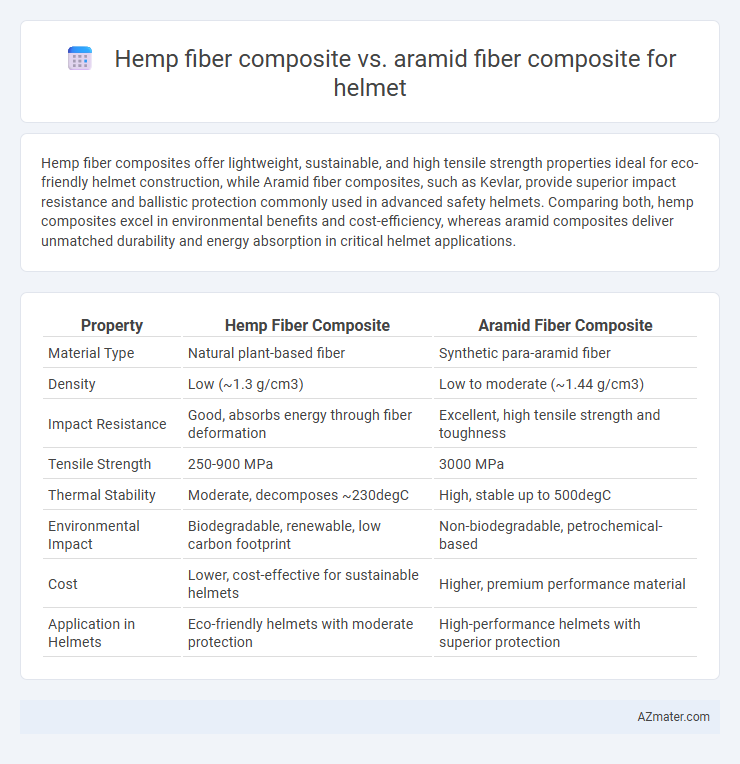Hemp fiber composites offer lightweight, sustainable, and high tensile strength properties ideal for eco-friendly helmet construction, while Aramid fiber composites, such as Kevlar, provide superior impact resistance and ballistic protection commonly used in advanced safety helmets. Comparing both, hemp composites excel in environmental benefits and cost-efficiency, whereas aramid composites deliver unmatched durability and energy absorption in critical helmet applications.
Table of Comparison
| Property | Hemp Fiber Composite | Aramid Fiber Composite |
|---|---|---|
| Material Type | Natural plant-based fiber | Synthetic para-aramid fiber |
| Density | Low (~1.3 g/cm3) | Low to moderate (~1.44 g/cm3) |
| Impact Resistance | Good, absorbs energy through fiber deformation | Excellent, high tensile strength and toughness |
| Tensile Strength | 250-900 MPa | 3000 MPa |
| Thermal Stability | Moderate, decomposes ~230degC | High, stable up to 500degC |
| Environmental Impact | Biodegradable, renewable, low carbon footprint | Non-biodegradable, petrochemical-based |
| Cost | Lower, cost-effective for sustainable helmets | Higher, premium performance material |
| Application in Helmets | Eco-friendly helmets with moderate protection | High-performance helmets with superior protection |
Introduction to Fiber Composites in Helmet Manufacturing
Hemp fiber composites offer lightweight, sustainable alternatives with excellent impact absorption, making them increasingly popular in helmet manufacturing for reducing environmental impact while maintaining strength. Aramid fiber composites, such as Kevlar, provide superior tensile strength and ballistic resistance, widely favored in high-performance helmets for enhanced safety and durability. The choice between hemp and aramid fiber composites depends on balancing sustainability goals with technical performance demands in protective helmet applications.
Overview of Hemp Fiber Composites
Hemp fiber composites in helmets offer a sustainable alternative with excellent impact absorption and lightweight properties, enhancing user comfort and safety. These composites combine natural hemp fibers with resin matrices, resulting in improved tensile strength and durability while reducing environmental impact compared to synthetic fibers. Advanced hemp fiber composites demonstrate competitive performance in energy dissipation, making them a viable option for eco-friendly helmet manufacturing.
Overview of Aramid Fiber Composites
Aramid fiber composites, known for their exceptional strength-to-weight ratio and high impact resistance, are widely used in helmet manufacturing to provide enhanced protection and durability. These composites exhibit superior thermal stability and resistance to abrasion compared to hemp fiber composites, making them ideal for applications requiring reliable performance under extreme conditions. Their inherent toughness and ability to absorb and dissipate energy significantly improve helmet safety standards while maintaining lightweight comfort.
Mechanical Properties: Strength and Durability
Hemp fiber composites exhibit high tensile strength and excellent impact resistance, making them a sustainable yet robust option for helmet construction. Aramid fiber composites, such as Kevlar, offer superior tensile strength, exceptional durability, and outstanding resistance to abrasion and cutting, ensuring enhanced protection in extreme conditions. The choice between hemp and aramid fiber composites depends on balancing eco-friendliness with maximum mechanical performance requirements in helmet safety.
Weight and Ergonomic Considerations
Hemp fiber composites offer a lightweight alternative to aramid fiber composites, reducing helmet weight by up to 20%, which enhances user comfort and minimizes neck strain during prolonged wear. The natural flexibility and breathability of hemp fibers contribute to improved ergonomics by allowing better ventilation and moisture management compared to the stiffer aramid composites. While aramid fibers provide superior impact resistance, hemp composites balance protective performance with weight reduction, making them ideal for ergonomic helmet designs.
Impact Resistance and Safety Performance
Hemp fiber composite offers excellent impact resistance due to its natural toughness and energy absorption capabilities, making it a sustainable choice for helmet construction. Aramid fiber composite, such as Kevlar, provides superior safety performance with high tensile strength and exceptional resistance to penetration, commonly used in ballistic and high-impact helmets. While hemp composites deliver good shock absorption and lightweight properties, aramid fibers ensure enhanced durability and protection in extreme impact scenarios.
Environmental Sustainability and Lifecycle Analysis
Hemp fiber composites offer superior environmental sustainability compared to aramid fiber composites due to their renewable sourcing, lower carbon footprint, and biodegradability, making them an eco-friendly choice for helmet manufacturing. Lifecycle analysis reveals hemp composites require less energy during production and generate fewer greenhouse gas emissions throughout their lifespan, improving overall sustainability metrics. Conversely, aramid fibers, though high-performance, have a more energy-intensive and non-biodegradable lifecycle, posing challenges for eco-conscious applications in helmet design.
Cost Comparison: Production and Material Expenses
Hemp fiber composites offer significant cost advantages in helmet production due to lower raw material prices and environmentally friendly processing methods, resulting in reduced material expenses compared to aramid fiber composites. Aramid fibers, such as Kevlar, incur higher production costs driven by complex chemical synthesis and energy-intensive manufacturing processes, which elevate the overall helmet price. Manufacturers often balance these costs against performance requirements, with hemp providing a budget-friendly alternative for less demanding applications.
Applications and Real-World Performance
Hemp fiber composites provide lightweight, sustainable alternatives for helmet shells with excellent impact absorption and vibration damping, making them ideal for eco-friendly protective gear. Aramid fiber composites, such as Kevlar(r), deliver superior tensile strength and abrasion resistance, widely used in ballistic helmets and advanced military applications. In real-world performance, hemp fiber composites excel in comfort and environmental impact, while aramid composites ensure maximum protection under high-velocity impacts and extreme conditions.
Future Trends and Innovations in Helmet Composites
Hemp fiber composites are gaining traction in helmet manufacturing due to their sustainability, low environmental impact, and good impact absorption properties, making them a promising alternative to traditional aramid fiber composites. Innovations in bio-based resin systems and hybrid composite structures are advancing the performance and durability of hemp fiber helmets, positioning them as cost-effective and eco-friendly solutions in personal protective equipment. Research focuses on enhancing the mechanical properties and moisture resistance of hemp composites to meet or exceed the high-strength and thermal stability standards set by aramid fibers in helmet safety certifications.

Infographic: Hemp fiber composite vs Aramid fiber composite for Helmet
 azmater.com
azmater.com